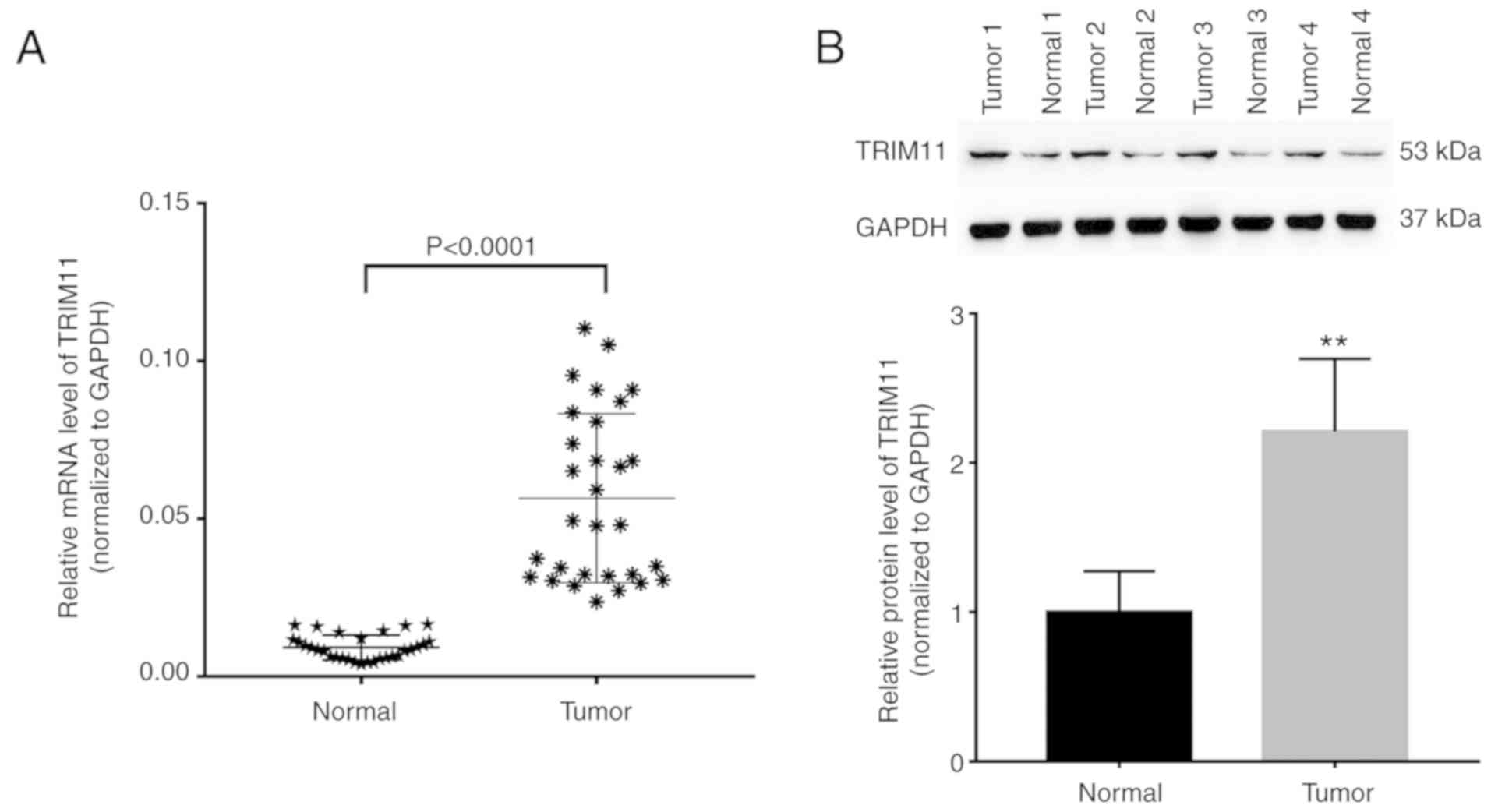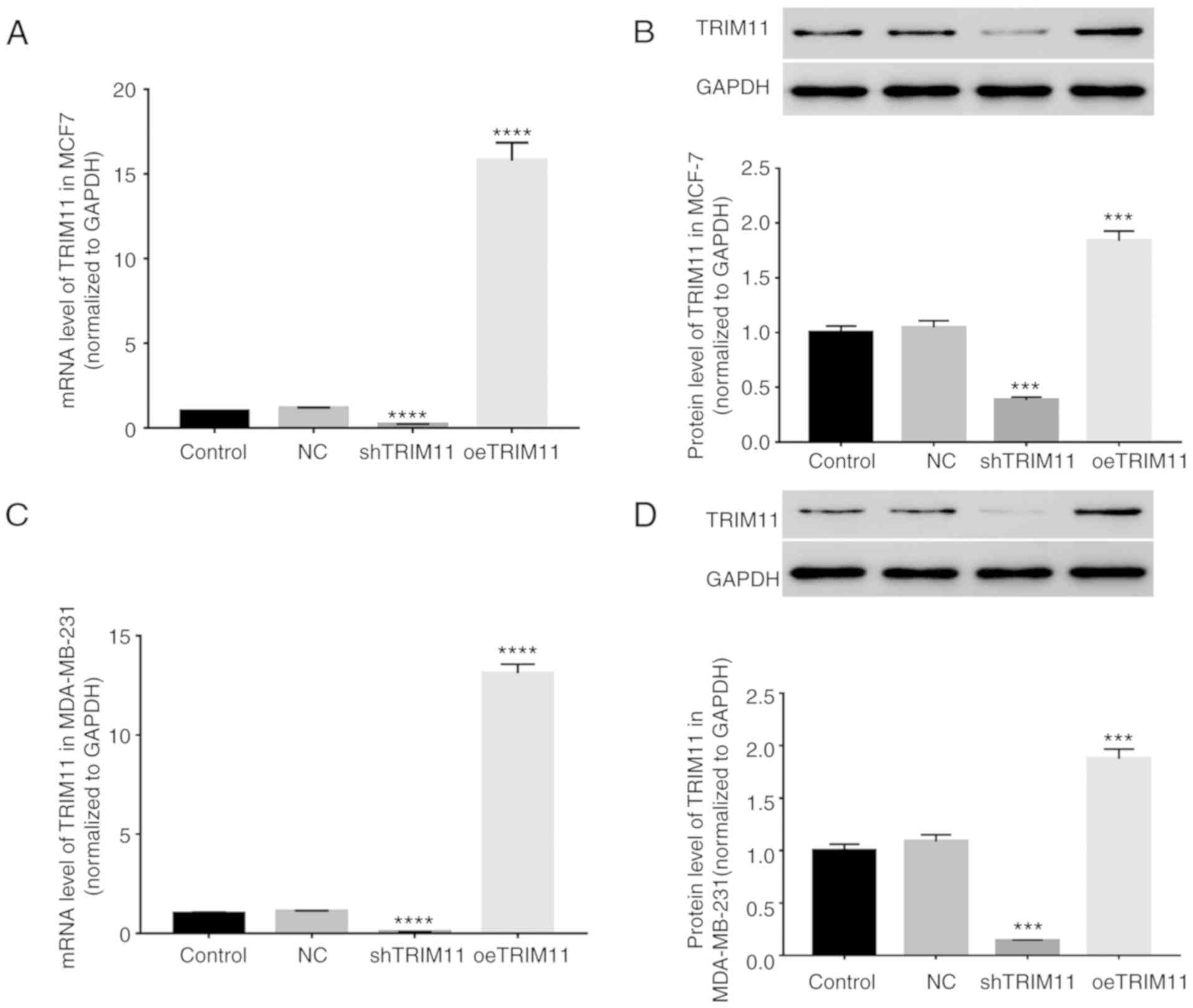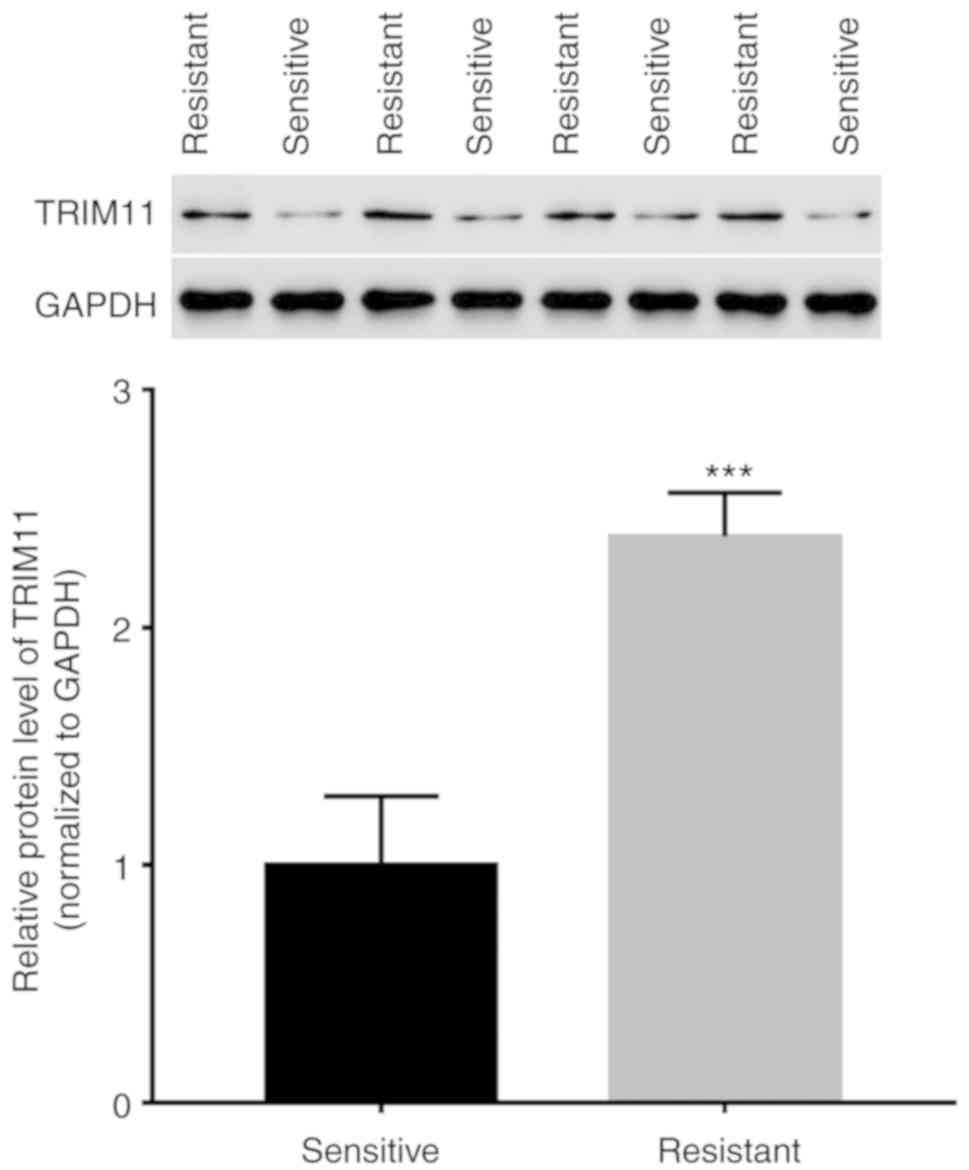Introduction
Breast cancer is a malignant tumor that occurs in
the mammary glandular epithelium. Similar to ovarian cancer, breast
cancer also causes great harm to the health of females, with 99% of
breast cancer diagnoses occurring in females and only 1% of
diagnoses occurring in males (1).
Therefore, breast cancer is regarded as a common cause of
cancer-associated mortality in females. The global incidence of
breast cancer has been increasing since the late 1970s. The
majority of the patients who are diagnosed with early-stage breast
cancer can be cured by surgery, but surgery is unable to completely
prevent the metastasis of tumors (2,3).
Over recent decades, a variety of drugs have been
developed for the treatment of breast cancer. Cisplatin, first
developed in 1845 (4), is regarded
as the first-line chemotherapy option, not only in breast cancer,
but also in other types of cancer, including ovarian cancer
(5). Paclitaxel, another drug
isolated in 1962 (6–8), has similar effects to cisplatin on
cancer types, including breast and ovarian cancer (9). In addition, adriamycin (doxorubicin)
(10,11), gemcitabine (12) and fluorouracil (5-FU) (13) are also used as chemotherapeutic
agents for the clinical treatment of breast and lung cancer, and
other types of cancer. Nonetheless, due to the development of drug
resistance, chemotherapy cannot always cure breast cancer or other
types of cancer, and is likely to be accompanied by the recurrence
of cancer metastasis (14).
Tripartite motif-containing 11 (TRIM11) is a member
of the TRIM family, which was identified to contain E3 ubiquitin
ligases. TRIM proteins were characterized by the presence of a
tripartite motif consisting of three conserved domains, including
RING, B-box and a coiled-coil region (15,16).
Recent studies have demonstrated that TRIM11 is an oncogene and is
involved in several types of cancer, including lung cancer
(17), colon cancer (18) and ovarian cancer (19). For example, the downregulation of
TRIM11 in ovarian cancer inhibited the proliferation and invasion
of tumor cells (19), and
increasing TRIM11 expression in lung cancer was correlated with a
poor prognosis of patients (17).
Additionally, studies have associated the abnormal expression of
TRIM proteins with the development of breast cancer (20–22).
For example, the expression of TRIM24 was significantly increased
in breast cancer tissues, and its overexpression was associated
with a poor prognosis of patients with breast cancer (20,21).
Furthermore, it was reported that TRIM29 functioned as a tumor
suppressor in breast cancer (22).
However, little is known regarding the changes in the expression
and function of TRIM11 in breast cancer.
In the present study, elevated TRIM11 levels were
detected in breast cancer tissues, which suggested that TRIM11 may
be involved in breast cancer progression. In MCF-7 and MDA-MB-231
cells, TRIM11 downregulation suppressed cell proliferation and
accelerated apoptosis, whereas upregulation of TRIM11 had the
opposite effect, which was accompanied by significant alterations
in apoptosis-associated genes. Furthermore, TRIM11 downregulation
enhanced the pro-apoptotic effect of chemotherapy drugs on breast
cancer cells, and high TRIM11 expression was observed in cisplatin-
and paclitaxel-resistant breast cancer tissues. Therefore, it was
hypothesized that the downregulation of TRIM11 may be beneficial
for the treatment of breast cancer.
Materials and methods
Breast cancer tissues and adjacent
normal tissues
A total of 30 patients with breast cancer treated at
the Affiliated Hospital of Binzhou Medical University (Yantai,
China) were enrolled in the present study. The mean age of the
patients was 55 years (age range, 50–65 years). Following the
receipt of written informed consent, paired tumor and adjacent
normal tissues were collected from the patients between June 6 and
December 15, 2016 and immediately frozen and stored in liquid
nitrogen at −196°C prior to use. Following the extraction of total
RNA and proteins from these samples, the expression of TRIM11 was
detected by reverse transcription-quantitative polymerase chain
reaction (RT-qPCR) and western blot analysis. All experiments
conducted in the present study were approved by the Ethics
Committee of Binzhou Medical University.
Cell culture
Human breast cancer MCF-7 and MDA-MB-231 cell lines
were obtained from Type Culture Collection of the Chinese Academy
of Science (Shanghai, China) and cultured in Dulbecco's modified
Eagle's medium (DMEM; HyClone; GE Healthcare Life Sciences, Logan,
UT, USA) containing 10% fetal bovine serum (Gibco; Thermo Fisher
Scientific, Inc., Waltham, MA, USA) and 1% antibiotic (a mixture of
penicillin and streptomycin; Beijing Solarbio Science &
Technology Co., Ltd., Beijing, China) in a 5% CO2
incubator (Thermo Fisher Scientific, Inc., Waltham, MA, USA) at
37°C. During the period of incubation, the medium was changed every
two days.
Construction of the lentivirus
TRIM11 short hairpin RNA (shRNA)
(3′-CAGAAGTTGTGCCTATGGA-5′) and a negative control shRNA
(3′-CCTAAGGTTAAGTCGCCCTCG-5′) were applied to construct RNA
interference lentiviruses. The coding DNA sequence region of TRIM11
synthesized by Genewiz, Inc. (South Plainfield, NJ, USA) was
inserted into EcoRI/BamHI restriction sites of a
pLVX-AcGFP1-C1 plasmid and confirmed by DNA sequencing (Shanghai
Majorbio Pharmaceutical Technology Co., Ltd., Shanghai, China).
Lentiviral constructs of pLKO.1-shTRIM11 (1,000 ng),
pLVX-AcGFP1-C1-TRIM11 (1,000 ng) or pLVX-AcGFP1-C1, and pLKO.1
(Addgene, Inc., Cambridge, MA, USA) empty vectors were
co-transfected with psPAX2 and pMD2.G (Addgene, Inc.) viral
packaging plasmids into 293T cells by Lipofectamine 2000
(Invitrogen; Thermo Fisher Scientific, Inc.). Following
transfection for 48 h, the viral supernatant that was used to
infect MCF-7 and MDA-MB-231 cells was collected (17).
Division of the experimental
groups
To regulate TRIM11 expression in the MCF-7 and
MDA-MB-231 cells, lentivirus-mediated RNA interference and
overexpression were used, and four groups of cultured cells were
determined: The first group consisted of wild-type cells cultured
with DMEM (Control); the second group consisted of cells infected
with the negative control (NC) lentivirus; the third group
consisted of cells infected with the TRIM11 shRNA lentivirus
(shTRIM11); and the fourth group consisted of cells infected with
the TRIM11 recombinant lentivirus (oeTRIM11). Following infection
for 0, 24, 48 or 72 h, proliferation assays were performed, and
RT-qPCR and western blot analyses were performed, as well as
apoptosis assays 48 h later.
To further investigate the impact of TRIM11 on
breast cancer, following downregulation of TRIM11, the cells were
treated with 5 µg/ml cisplatin, paclitaxel, adriamycin, 5-FU or
gemcitabine individually for 24 h. In addition, the apoptosis rates
of MCF-7 and MDA-MB-231 cells were detected using flow cytometric
analysis.
Proliferation assay
Cells in the logarithmic growth phase were digested
by 0.25% trypsin (Beijing Solarbio Science & Technology Co.,
Ltd.), inoculated in 96-well culture plates at a density of
3×103 cells/well and then cultured at 37°C in a 5%
CO2 humidified incubator overnight. On the next day,
according to the aforementioned experimental grouping, the cells
were infected with lentivirus for 0, 24, 48 and 72 h. Subsequently,
100 µl 10% Cell Counting Kit-8 (CCK-8; SAB Biotherapeutics, Inc.,
Sioux Falls, SD, USA) solution in serum-free DMEM was added to each
well and incubated for 1 h. Finally, the optical density of the
absorbance at 450 nm was measured using a microplate reader
(Perlong Medical Equipment Co., Ltd., Beijing, China).
RNA extraction and RT-qPCR
Following extraction from tissue samples or
lentivirus-infected MCF-7 cells by TRIzol (Invitrogen; Thermo
Fisher Scientific, Inc.), total RNA was quantified and then 1%
agarose gel electrophoresis was used to confirm the integrity of
the isolated RNA. Subsequently, isolated RNA was reverse
transcribed into cDNA with a procedure of 37°C for 30 min, 85°C for
5 min and 4°C for 5 min using a reverse transcriptase kit
(Fermentas; Thermo Fisher Scientific, Inc.). RT-qPCR reactions were
conducted on an ABI Prism 7300 instrument (Applied Biosystems;
Thermo Fisher Scientific, Inc.) with a SYBR-Green PCR kit (Thermo
Fisher Scientific, Inc.). Subsequently, the mRNA level of TRIM11
normalized to GAPDH was analyzed by the 2−∆∆Cq method
(23). The primer sequences used
were as follows: TRIM11 forward, 5′-GAGAACGTGAACAGGAAGGAG-3′ and
reverse, 5′-CCATCGGTGGCACTGTAGAA-3′; GAPDH forward,
5′-CACCCACTCCTCCACCTTTG-3′ and reverse, 5′-CCACCACCCTGTTGCTGTAG-3′.
In addition, the thermocycling conditions were as follows: 95°C for
10 min, followed by 40 cycles of 95°C for 15 sec and 60°C for 45
sec; 95°C for 15 sec and 60°C for 1 min for one cycle; and 95°C for
15 sec and 60°C for 15 sec for one cycle (24).
Extraction of protein and western blot
analysis
Radioimmunoprecipitation assay lysis buffer (Beijing
Solarbio Science & Technology Co., Ltd.) containing protease
and phosphatase inhibitors was used to homogenize the cells or
tissue samples by incubation at 4°C for 30 min. Next, cells or
tissue lysates were centrifuged at 12,000 × g at 4°C for 10 min,
and the proteins in the supernatant were acquired and later
quantified by a bicinchoninic acid protein quantification kit
(Thermo Fisher Scientific, Inc.). SDS-PAGE (10%; JRDUN
Biotechnology Co., Ltd., Shanghai, China) was applied to separate
the proteins (25 µg), followed by semi-dry transfer onto
polyvinylidene fluoride membranes (EMD Millipore, Billerica, MA,
USA) by electroblotting. Subsequently, 5% skimmed milk (BD
Biosciences, Franklin Lakes, NJ, USA) was used to block the
membranes for 1 h at room temperature. Next, the membranes were
incubated with primary antibodies against TRIM11 (1:2,000; cat. no.
Ab111694; Abcam, Cambridge, UK), tumor protein p53 [p53; 1:1,000;
cat. no. 2524, Cell Signaling Technology (CST), Inc., Danvers, MA,
USA], phosphatase and tensin homolog (PTEN; 1:1,000; cat. no. 9552;
CST, Inc.), B-cell lymphoma 2 (Bcl-2; 1:200; cat. no. Sc-492; Santa
Cruz Biotechnology, Inc., Dallas, TX, USA), Bcl-2-associated X
protein (Bax; 1:300; cat. no. Sc-493; Santa Cruz Biotechnology,
Inc.), phosphorylated c-Jun N-terminal kinase 1/2 (p-JNK1/2;
1:2,000; cat. no. 9255; CST, Inc.), JNK1/2 (1:1,000; cat. no. 9252;
CST, Inc.), phosphorylated extracellular signal-regulated kinase
1/2 (p-ERK1/2; 1:1,000; cat. no. 9101; CST, Inc.), ERK1/2 (1:1,000;
cat. no. 9102; CST, Inc.) or GAPDH (1:2,000; cat. no. 5174; CST,
Inc.) at 4°C overnight with gentle agitating. Following 5–6 washes,
the membranes were incubated with horseradish peroxidase
(HRP)-labeled secondary antibodies (1:1,000; Beyotime Institute of
Biotechnology, Haimen, China) of goat anti-rabbit (cat. no. A0208)
and goat anti-mouse (cat. no. A0216) at 37°C for 1 h. Finally, the
membranes were incubated in the dark with immobilon western
chemiluminescent horseradish peroxidase substrate (EMD Millipore)
for 5 min and the protein bands were visualized under an enhanced
chemiluminescence imaging system (Tanon-5200; Tanon Science and
Technology Co., Ltd., Shanghai, China). GAPDH as an endogenous
reference gene, the relative protein expression levels were
calculated by ImageJ software 1.47v (National Institutes of Health,
Bethesda, MD, USA).
Cell apoptosis analysis
A flow cytometer (BD Biosciences) was used to detect
the proportion of apoptotic cells. Treated cells were digested,
resuspended and counted. Resuspended cells (5,000,000–10,000,000)
were centrifuged at 1,000 × g for 5 min to obtain the cell
precipitants. Subsequently, the cells were resuspended gently with
195 µl binding buffer for Annexin V-fluorescein isothiocyanate
(FITC) staining. Next, following incubation with 5 µl Annexin
V-FITC (Beyotime Institute of Biotechnology) for 15 min in the dark
at 4°C, 5 µl propidium iodide (PI) was added and cells were
incubated for a further 5 min at 4°C. Simultaneously, a tube
without Annexin V-FITC or PI was used as a negative control.
Subsequently, the cell apoptosis rates were determined by flow
cytometry (FCM) and analyzed using BD Accuri™ C6 Software (Version
1.0.264.21; BD Biosciences).
Statistical analysis
All the statistical analyses were performed using
GraphPad Prism 7.0 software (GraphPad Software, Inc., La Jolla, CA,
USA). Student's t-tests were performed to assess the quantitative
data compared between two groups, and one-way analysis of variance
was used for multiple comparisons. All data were based on at least
three independent experiments and values are presented as the mean
± standard deviation. P<0.05 was considered to indicate a
statistically significant difference.
Results
TRIM11 expression is significantly
increased in the tumor tissues of patients with breast cancer
A total of 30 paired tumor and normal tissues of
patients with breast cancer were collected, and RT-qPCR and western
blot analysis were applied to quantify TRIM11 expression levels in
these tissues. As demonstrated in Fig.
1, statistical analysis by Student's t-tests revealed that mRNA
(Fig. 1A) and protein (Fig. 1B) levels of TRIM11 were
significantly higher in the breast cancer tissues than in the
normal tissues, which indicated that TRIM11 may serve a pivotal
role in the progression of breast cancer.
Downregulation and upregulation of
TRIM11 in MCF-7 and MDA-MB-231 cell lines
For further study, breast cancer MCF-7 and
MDA-MB-231 cells were infected with TRIM11 interference and
overexpression lentiviruses to downregulate and upregulate TRIM11
expression, respectively. After 48 h of infection, mRNA and protein
expression levels of TRIM11 were quantified by RT-qPCR and western
blot analysis, respectively. As demonstrated in Fig. 2, in MCF-7 (Fig. 2A and B) and MDA-MB-231 (Fig. 2C and D) cells, TRIM11 expression was
significantly reduced when infected with the shTRIM11 lentivirus,
whereas significantly increased expression was observed following
infection with the oeTRIM11 lentivirus. Therefore, the TRIM11
lentiviruses were applied in the subsequent experiments due to
their effective regulation of TRIM11 expression.
The effects of TRIM11 on the viability
and apoptosis of MCF-7 and MDA-MB-231 cells
Following downregulation and upregulation of TRIM11
expression in MCF-7 and MDA-MB-231 cells, cell viability was
evaluated by CCK-8 assay, and FCM with Annexin V-FITC/PI staining
was performed to detect cell apoptosis rates. As demonstrated in
Fig. 3, TRIM11 silencing
significantly decreased the cell proliferation rates of MCF-7
cells, whereas there was a significant increase in cell
proliferation when TRIM11 was overexpressed (Fig. 3A). In addition, the effect of TRIM11
on MCF-7 cell apoptosis was opposite to its effect on the cell
proliferation (Fig. 3B).
Additionally, downregulation and upregulation of TRIM11 also had
the same effect on the proliferation and apoptosis of MDA-MB-231
cells (Fig. 3C and D). These data
demonstrated that TRIM11 has an effect on the growth and survival
of breast cancer cells by promoting cell proliferation and
inhibiting cell apoptosis.
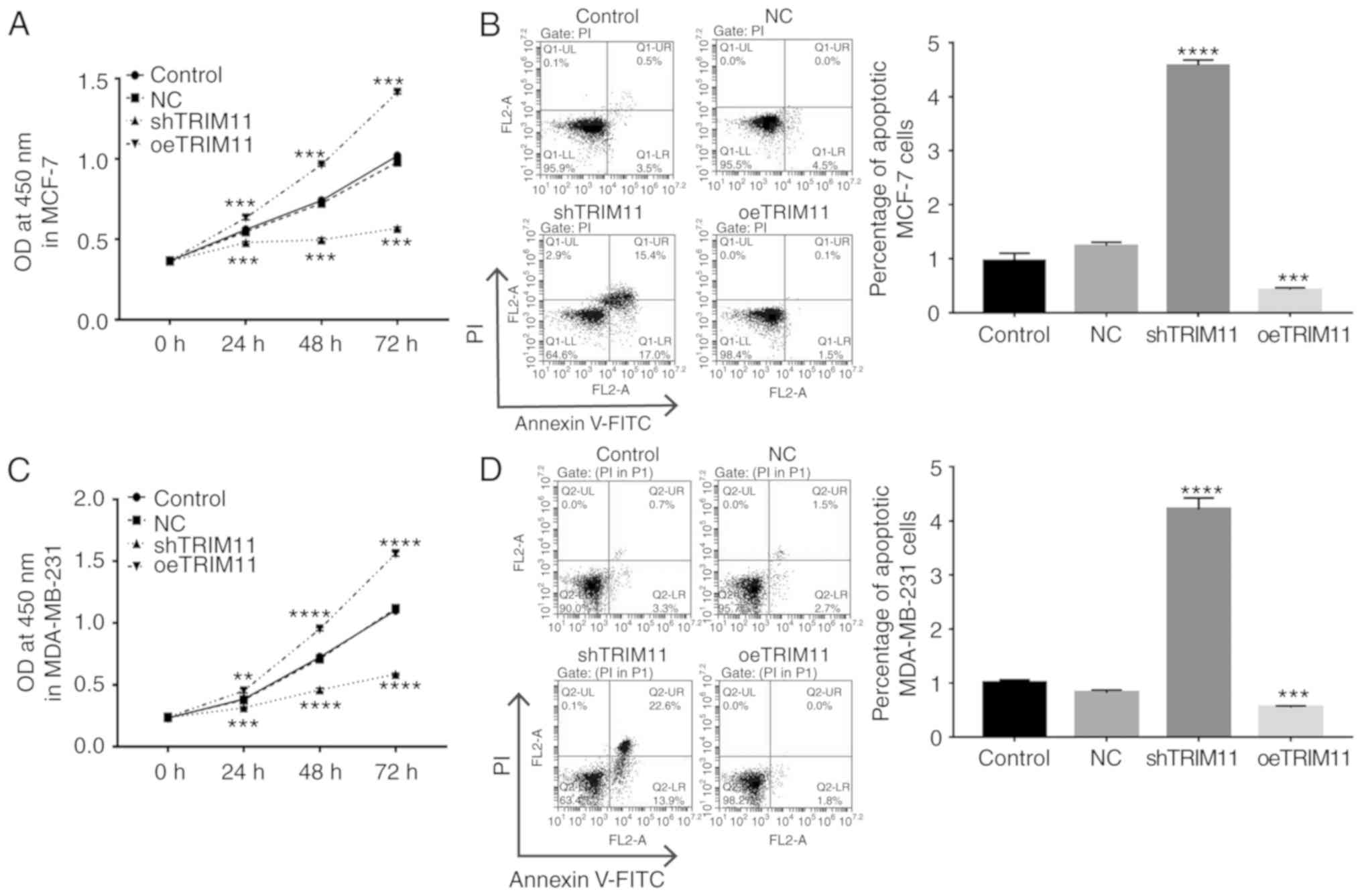 | Figure 3.The effects of TRIM11 on the
viability and apoptosis of MCF-7 and MDA-MB-231 cells. After 0, 24,
48 and 72 h of lentiviral infection, cell proliferation rates of
(A) MCF-7 and (C) MDA-MB-231 cells were evaluated by Cell Counting
Kit-8 assays. After 48 h, apoptotic cells in (B) MCF-7 and (D)
MDA-MB-231 cells were detected by flow cytometric analysis using
Annexin V-FITC/PI double staining. Early apoptotic cells that were
stained with Annexin-V but not with PI are in the lower right
quadrant, late apoptotic cells or necrotic cells that were stained
the two dyes are in the upper right quadrant, while the lower left
quadrant represents live cells. All data are presented as the mean
± standard deviation. **P<0.01, ***P<0.001, ****P<0.0001,
compared with the NC. OD, optical density; TRIM11, tripartite
motif-containing 11; FITC, fluorescein isothiocyanate; PI,
propidium iodide; NC, negative control; sh, short hairpin RNA; oe,
overexpression. |
The expression changes of several
associated genes following TRIM11 downregulation and
upregulation
The present study also further investigated the
mechanism underlying the anti-apoptotic effect of TRIM11
downregulation on breast cancer cells. Following TRIM11
downregulation and upregulation, the protein levels of several
associated genes were examined by western blot analysis. As
demonstrated in Fig. 4, in MCF-7
(Fig. 4A) and MDA-MB-231 (Fig. 4B) cells, the expression of
apoptosis-associated genes PTEN, p53 and Bax was significantly
increased when TRIM11 was downregulated. By contrast, PTEN, p53 and
Bax expression levels were markedly reduced following TRIM11
upregulation. In addition, the levels of Bcl-2, p-ERK1/2 and
p-JNK1/2 were positively associated with the alterations in TRIM11
expression, while ERK1/2 and JNK1/2 expression levels were
unchanged. PTEN, p53 and Bax are pro-apoptotic proteins (25), and the ratio of Bax/Bcl-2 was
reported to determine whether or not a cell was committed to
apoptosis (26). All data revealed
that TRIM11 may facilitate the proliferation of breast cancer cells
through activating ERK1/2 and JNK1/2 signaling, which further
regulates the expression of apoptosis-associated genes.
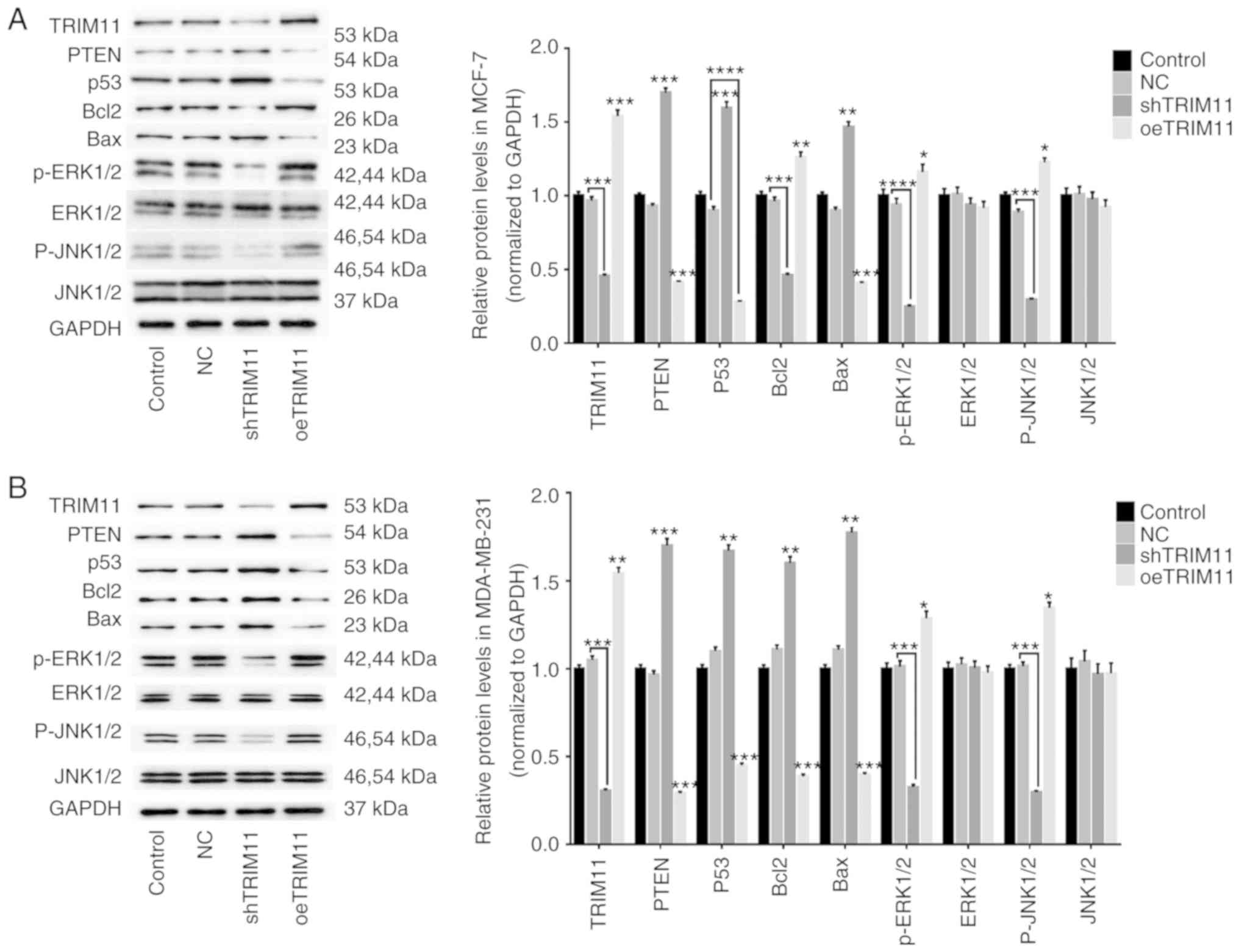 | Figure 4.The expression changes of several
associated genes following TRIM11 downregulation and upregulation.
At 48 h after lentiviral infection, protein levels of TRIM11, PTEN,
p53, Bcl2, Bax, p-ERK1/2, ERK1/2, p-JNK1/2, JNK1/2 in MCF-7 (A) and
MDA-MB-231 (B) cells were quantified by western blot analysis. Data
are expressed as the mean ± standard deviation. *P<0.05,
**P<0.01, ***P<0.001, ****P<0.0001, compared with the NC.
TRIM11, tripartite motif-containing 11; NC, negative control; sh,
short hairpin RNA; oe, overexpression; PTEN, phosphatase and tensin
homolog; p53, tumor protein p53; Bcl-2, B-cell lymphoma 2; Bax,
Bcl-2-associated X protein; p-ERK1/2, phosphorylated extracellular
signal-regulated kinase; p-JNK1/2, phosphorylated c-Jun N-terminal
kinase 1/2. |
Downregulation of TRIM11 enhances the
effects of chemotherapeutic drugs on the apoptosis of MCF-7 and
MDA-MB-231 cells
Previous studies have demonstrated that the
chemotherapeutic drugs cisplatin, paclitaxel, adriamycin, 5-FU and
gemcitabine are widely used in the clinical treatment of breast
cancer and other cancer types (5,9–13).
Additionally, it was reported that 5 µM cisplatin significantly
inhibited the proliferation rate of breast cancer cells (27). To further investigate the effects of
TRIM11, the aforementioned drugs were utilized and the cell
apoptosis rates were measured after 24 h of treatment. As
demonstrated in Fig. 5, in MCF-7
(Fig. 5A) and MDA-MB-231 (Fig. 5B) cells, cisplatin and paclitaxel
had a more significant pro-apoptotic effect on cell apoptosis.
Furthermore, following TRIM11 downregulation, the pro-apoptotic
effects of these chemotherapeutic drugs were markedly stronger.
Therefore, the results suggested that downregulation of TRIM11 can
enhance the pro-apoptotic effects of chemotherapeutic drugs on
breast cancer cells.
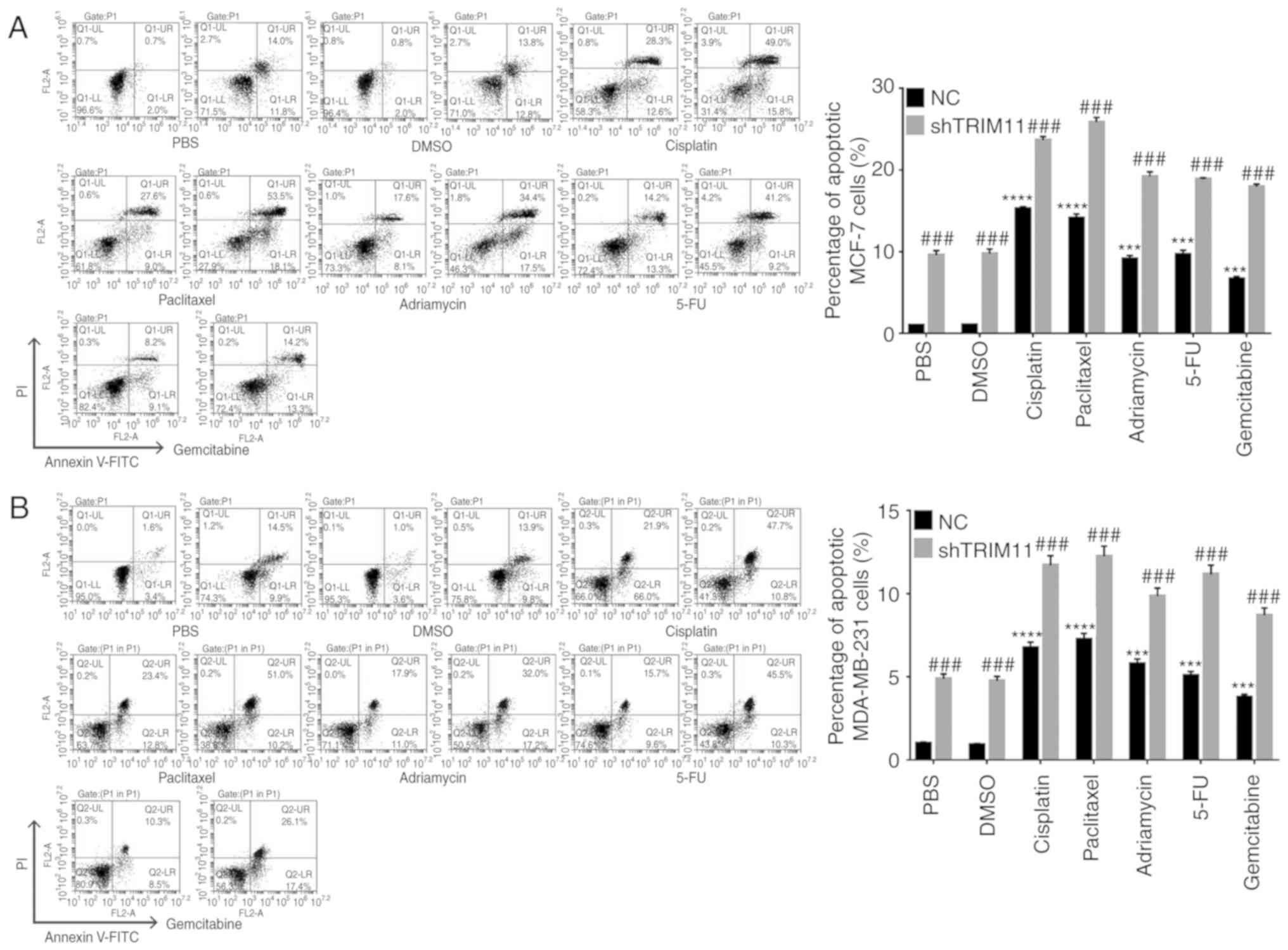 | Figure 5.Downregulation of TRIM11 enhances the
effects of chemotherapeutic drugs on the apoptosis of (A) MCF-7 and
(B) MDA-MB-231 cells. Following infection with the shTRIM11
lentivirus, (A) MCF-7 and (B) MDA-MB-231 cells were individually
treated with five chemotherapeutic drugs (5 µg/ml). After 24 h, the
cells were collected to determine their apoptosis rates by flow
cytometric analysis. PBS and DMSO were used as vehicle controls.
Data are presented as the mean ± standard deviation. ***P<0.001,
****P<0.0001, compared with vehicle controls;
###P<0.001, compared with NC. TRIM11, tripartite
motif-containing 11; NC, negative control; sh, short hairpin RNA;
DMSO, dimethyl sulfoxide; 5-FU, fluorouracil. |
TRIM11 expression is increased in
cisplatin- and paclitaxel- resistant breast cancer tissues
A total of 4 pairs of cisplatin- and
paclitaxel-sensitive and -resistant breast cancer tissues were
collected to examine TRIM11 levels. As demonstrated in Fig. 6, a significant increase in the
protein expression of TRIM11 was noted in the resistant tissues,
whereas TRIM11 expression was much lower in the sensitive tissues.
These data further suggested that TRIM11 downregulation enhanced
the pro-apoptotic effects of chemotherapeutic drugs, which may be
beneficial for the treatment of breast cancer.
Discussion
Although the breast is not an essential organ for
human life, and breast cancer in situ is not fatal, the
incidence of breast cancer has increased annually, causing serious
damage to female physical and mental health. The pathophysiology of
breast cancer has been studied for decades, but its cause requires
further studies. The present study revealed that TRIM11 was
important in the progression of breast cancer by regulating cell
proliferation and apoptosis via activating the ERK1/2 and JNK1/2
signaling pathways.
Several members of the TRIM family have been
revealed to function in breast cancer to date. For instance,
knockdown of TRIM37, a breast cancer oncoprotein, decreases tumor
growth (28). In addition, the
proliferation of breast cancer cells was decreased due to the
silencing of TRIM46 (29). In the
present study, increased TRIM11 expression in breast cancer tissues
may be associated with the progression of breast cancer; therefore,
TRIM11 is likely to be a novel diagnostic indicator for breast
cancer. In MCF-7 and MDA-MB-231 cells, downregulation of TRIM11 had
an inhibitory effect on cell proliferation and a promoting effect
on cell apoptosis, whereas TRIM11 overexpression resulted in
opposite effects, which directly suggests an important role of
TRIM11 in the proliferation and survival of breast cancer cells.
Furthermore, PTEN, p53 and Bax expression levels were significantly
increased with TRIM11 downregulation, while Bcl-2, p-ERK1/2 and
p-JNK1/2 expression levels were decreased. PTEN, a lipid
phosphatase, is a tumor suppressor that has been associated with
several types of human cancer, and PTEN is frequently decreased in
late-stage breast cancer (30).
p53, also a tumor suppressor protein, may be a potential
trans-regulator of Bcl-2 (31). A
high expression level of Bcl-2 was detected in several solid tumor
types, including breast cancer (32). Additionally, Bax is considered to be
the main effector of apoptosis and functions in numerous types of
human cancer (33). The binding
site of p53 was identified in the promoter of the Bax gene, and Bax
was strongly trans-activated by p53 (34,35).
In addition, signaling pathways, including ERK, JNK and p38 proved
to be major determinants in various processes, including survival,
apoptosis and proliferation (36,37).
It has been reported that ERK1/2 (38) and JNK1/2 (39) may be associated with breast cancer,
and that the expression levels of Bcl-2, Bax and p-ERK were
affected by TRIM11 expression (19). Therefore, TRIM11 downregulation
resulted in a beneficial effect on breast cancer possibly through
activating ERK1/2 and JNK1/2 signaling, and regulating the
expression of apoptosis-associated genes. These results are further
supported by the observations that TRIM11 downregulation enhanced
the pro-apoptotic effect of chemotherapeutic drugs, and that TRIM11
was increased in cisplatin- and paclitaxel-resistant breast cancer
tissues.
In summary, the present study demonstrated that
TRIM11 downregulation may improve the treatment of breast cancer by
activating ERK1/2 and JNK1/2 signaling. TRIM11 may provide a novel
direction for the study of the pathogenesis and treatment of breast
cancer.
Acknowledgements
Not applicable.
Funding
No funding was received.
Availability of data and materials
All data generated or analyzed during this study are
included in this published article.
Authors' contributions
XD and MiL conceived and designed the study. XD, FG
and MeL performed the experiments. XD and MiL wrote the manuscript.
All authors read and approved the final manuscript.
Ethics approval and consent to
participate
All experiments conducted in the present study were
approved by the Ethics Committee of Binzhou Medical University and
written informed consent was obtained from all participants.
Patient consent for publication
Not applicable.
Competing interests
The authors declare that they have no competing
interests.
References
|
1
|
Howlader N, Noone AM, Krapcho M, Garshell
J, Miller D, Altekruse SF, Kosary CL, Yu M, Ruhl J, Tatalovich Z,
et al: SEER cancer statistics review, 1975–2012, National Cancer
Institute. 2013.
|
|
2
|
Demicheli R, Valagussa P and Bonadonna G:
Does surgery modify growth kinetics of breast cancer
micrometastases? Br J Cancer. 85:490–492. 2001. View Article : Google Scholar : PubMed/NCBI
|
|
3
|
Hansen E, Wolff N, Knuechel R, Ruschoff J,
Hofstaedter F and Taeger K: Tumor cells in blood shed from the
surgical field. Arch Surg. 130:387–393. 1995. View Article : Google Scholar : PubMed/NCBI
|
|
4
|
Galluzzi L, Vitale I, Michels J, Brenner
C, Szabadkai G, Harel-Bellan A, Castedo M and Kroemer G: Systems
biology of cisplatin resistance: Past, present and future. Cell
Death Dis. 5:e12572014. View Article : Google Scholar : PubMed/NCBI
|
|
5
|
Wang J and Wu GS: Role of autophagy in
cisplatin resistance in ovarian cancer cells. J Biol Chem.
289:17163–17173. 2014. View Article : Google Scholar : PubMed/NCBI
|
|
6
|
Walsh V and Goodman J: From taxol to
Taxol: The changing identities and ownership of an anti-cancer
drug. Med Anthropol. 21:307–336. 2002. View Article : Google Scholar : PubMed/NCBI
|
|
7
|
Liebmann JE, Cook JA, Lipschultz C, Teague
D, Fisher J and Mitchell JB: Cytotoxic studies of paclitaxel
(Taxol) in human tumour cell lines. Br J Cancer. 68:1104–1109.
1993. View Article : Google Scholar : PubMed/NCBI
|
|
8
|
Manfredi JJ and Horwitz SB: Taxol: An
antimitotic agent with a new mechanism of action. Pharmacol Ther.
25:83–125. 1984. View Article : Google Scholar : PubMed/NCBI
|
|
9
|
Kampan NC, Madondo MT, Mcnally OM, Quinn M
and Plebanski M: Paclitaxel and its evolving role in the management
of ovarian cancer. Biomed Res Int. 2015:4130762015. View Article : Google Scholar : PubMed/NCBI
|
|
10
|
Pritchard JE, Dillon PM, Conaway MR, Silva
CM and Parsons SJ: A mechanistic study of the effect of
doxorubicin/adriamycin on the estrogen response in a breast cancer
model. Oncology. 83:305–320. 2012. View Article : Google Scholar : PubMed/NCBI
|
|
11
|
Bao L, Haque A, Jackson K, Hazari S, Moroz
K, Jetly R and Dash S: Increased expression of P-glycoprotein is
associated with doxorubicin chemoresistance in the metastatic 4T1
breast cancer model. Am J Pathol. 178:838–852. 2011. View Article : Google Scholar : PubMed/NCBI
|
|
12
|
Siena L, Pace E, Ferraro M, Di Sano C,
Melis M, Profita M, Spatafora M and Gjomarkaj M: Gemcitabine
sensitizes lung cancer cells to Fas/FasL system-mediated killing.
Immunology. 141:242–255. 2014. View Article : Google Scholar : PubMed/NCBI
|
|
13
|
García MA, Carrasco E, Aguilera M, Alvarez
P, Rivas C, Campos JM, Prados JC, Calleja MA, Esteban M, Marchal
JA, et al: The chemotherapeutic drug 5-fluorouracil promotes
PKR-mediated apoptosis in a p53-independent manner in colon and
breast cancer cells. PLoS One. 6:e238872011. View Article : Google Scholar : PubMed/NCBI
|
|
14
|
Abe O, Abe R, Enomoto K, Kikuchi K, Koyama
H, Masuda H, Nomura Y, Sakai K, Sugimachi K, Tominaga T, et al:
Effects of chemotherapy and hormonal therapy for early breast
cancer on recurrence and 15-year survival: An overview of the
randomised trials. Lancet. 365:1687–1717. 2005. View Article : Google Scholar : PubMed/NCBI
|
|
15
|
Tomar D and Singh R: TRIM family proteins:
Emerging class of RING E3 ligases as regulator of NF-κB pathway.
Biol Cell. 107:22–40. 2015. View Article : Google Scholar : PubMed/NCBI
|
|
16
|
Hatakeyama S: TRIM proteins and cancer.
Nat Rev Cancer. 11:792–804. 2011. View
Article : Google Scholar : PubMed/NCBI
|
|
17
|
Wang X, Shi W, Shi H, Lu S, Kang W, Chao
S, He J, Jin W, Lv X, Zou H and Shu Y: TRIM11 overexpression
promotes proliferation, migration and invasion of lung cancer
cells. J Exp Clin Cancer Res. 35:1002016. View Article : Google Scholar : PubMed/NCBI
|
|
18
|
Yin Y, Zhong J, Li SW, Li JZ, Zhou M, Chen
Y, Sang Y and Liu L: TRIM11, a direct target of miR-24-3p, promotes
cell proliferation and inhibits apoptosis in colon cancer.
Oncotarget. 7:86755–86765. 2016. View Article : Google Scholar : PubMed/NCBI
|
|
19
|
Chen Y, Sun J and Ma J: Proliferation and
invasion of ovarian cancer cells are suppressed by knockdown of
TRIM11. Oncol Lett. 14:2125–2130. 2017. View Article : Google Scholar : PubMed/NCBI
|
|
20
|
Chambon M, Orsetti B, Berthe ML,
Bascoul-Mollevi C, Rodriguez C, Duong V, Gleizes M, Thénot S,
Bibeau F, Theillet C and Cavaillès V: Prognostic significance of
TRIM24/TIF-1α gene expression in breast cancer. Am J Pathol.
178:1461–1469. 2011. View Article : Google Scholar : PubMed/NCBI
|
|
21
|
Tsai WW, Wang Z, Yiu TT, Akdemir KC, Xia
W, Winter S, Tsai CY, Shi X, Schwarzer D, Plunkett W, et al: TRIM24
links a non-canonical histone signature to breast cancer. Nature.
468:927–932. 2010. View Article : Google Scholar : PubMed/NCBI
|
|
22
|
Ai L, Kim WJ, Alpay M, Ming T, Pardo CE,
Hatakeyama S, May WS, Kladde MP, Heldermon CD, Siegel EM, et al:
TRIM29 suppresses TWIST1 and invasive breast cancer behavior.
Cancer Res. 74:4875–4887. 2014. View Article : Google Scholar : PubMed/NCBI
|
|
23
|
Livak KJ and Schmittgen TD: Analysis of
relative gene expression data using real-time quantitative PCR and
the 2−ΔΔCT method. Methods. 25:402–408. 2001. View Article : Google Scholar : PubMed/NCBI
|
|
24
|
Hong JY, Kang B, Kim A, Hwang S, Ahn J,
Lee S, Kim J, Park JH and Cheon DS: Development of a highly
sensitive real-time one step RT-PCR combined complementary locked
primer technology and conjugated minor groove binder probe. Virol
J. 8:3302011. View Article : Google Scholar : PubMed/NCBI
|
|
25
|
Gao G and Dou QP: G1
phase-dependent expression of Βcl-2 mRNA and protein correlates
with chemoresistance of human cancer cells. Mol Pharmacol.
58:1001–1010. 2000. View Article : Google Scholar : PubMed/NCBI
|
|
26
|
Green DR and Reed JC: Mitochondria and
apoptosis. Science. 281:1309–1312. 1998. View Article : Google Scholar : PubMed/NCBI
|
|
27
|
Bu Y, Lu C, Bian C, Wang J, Li J, Zhang B,
Li Z, Brewer G and Zhao RC: Knockdown of Dicer in MCF-7 human
breast carcinoma cells results in G1 arrest and increased
sensitivity to cisplatin. Oncol Rep. 21:13–17. 2009.PubMed/NCBI
|
|
28
|
Bhatnagar S, Gazin C, Chamberlain L, Ou J,
Zhu X, Tushir JS, Virbasius CM, Lin L, Zhu LJ, Wajapeyee N and
Green MR: TRIM37 is a new histone H2A ubiquitin ligase and breast
cancer oncoprotein. Nature. 516:116–120. 2014.PubMed/NCBI
|
|
29
|
Li Z, Li X, Wei D, Sun C, Guo D and Zhang
L: Mmu-miR-1894-3p inhibits cell proliferation and migration of
breast cancer cells by targeting Trim46. Int J Mol Sci.
17:E6092016. View Article : Google Scholar : PubMed/NCBI
|
|
30
|
Li J, Yen C, Liaw D, Podsypanina K, Bose
S, Wang SI, Puc J, Miliaresis C, Rodgers L, McCombie R, et al:
PTEN, a putative protein tyrosine phosphatase gene mutated
in human brain, breast, and prostate cancer. Science.
275:1943–1947. 1997. View Article : Google Scholar : PubMed/NCBI
|
|
31
|
Miyashita T, Harigai M, Hanada M and Reed
JC: Identification of a p53-dependent negative response element in
the bcl-2 gene. Cancer Res. 54:3131–3135. 1994.PubMed/NCBI
|
|
32
|
Silvestrini R, Veneroni S, Daidone MG,
Benini E, Boracchi P, Mezzetti M, Di Fronzo G, Rilke F and Veronesi
U: The Bcl-2 protein: A prognostic indicator strongly related to
p53 protein in lymph node-negative breast cancer patients. J Natl
Cancer Inst. 86:499–504. 1994. View Article : Google Scholar : PubMed/NCBI
|
|
33
|
Zhao G, Zhu Y, Eno CO, Liu Y, Deleeuw L,
Burlison JA, Chaires JB, Trent JO and Li C: Activation of the
proapoptotic Bcl-2 protein Bax by a small molecule induces tumor
cell apoptosis. Mol Cell Biol. 34:1198–1207. 2014. View Article : Google Scholar : PubMed/NCBI
|
|
34
|
Miyashita T, Krajewski S, Krajewska M,
Wang HG, Lin HK, Liebermann DA, Hoffman B and Reed JC: Tumor
suppressor p53 is a regulator of bcl-2 and bax gene expression in
vitro and in vivo. Oncogene. 9:1799–1805. 1994.PubMed/NCBI
|
|
35
|
Miyashita T and Reed JC: Tumor suppressor
p53 is a direct transcriptional activator of the human bax gene.
Cell. 80:293–299. 1995. View Article : Google Scholar : PubMed/NCBI
|
|
36
|
Kohno M and Pouyssegur J: Targeting the
ERK signaling pathway in cancer therapy. Ann Med. 38:200–211. 2006.
View Article : Google Scholar : PubMed/NCBI
|
|
37
|
Lin A: Activation of the JNK signaling
pathway: Breaking the brake on apoptosis. Bioessays. 25:17–24.
2003. View Article : Google Scholar : PubMed/NCBI
|
|
38
|
Nunes-Xavier CE, Elson A and Pulido R:
Epidermal growth factor receptor (EGFR)-mediated positive feedback
of protein-tyrosine phosphatase epsilon (PTPepsilon) on ERK1/2 and
AKT protein pathways is required for survival of human breast
cancer cells. J Biol Chem. 287:3433–3444. 2012. View Article : Google Scholar : PubMed/NCBI
|
|
39
|
Cellurale C, Girnius N, Jiang F,
Cavanagh-Kyros J, Lu S, Garlick DS, Mercurio AM and Davis RJ: Role
of JNK in mammary gland development and breast cancer. Cancer Res.
72:472–481. 2012. View Article : Google Scholar : PubMed/NCBI
|















